

 GAZA
- april 2004
GAZA
- april 2004 Text
and pictures
Text
and pictures from
A.A.
from
A.A. 13th
swiss civile mission
13th
swiss civile mission



 Eretz,
entry to Gaza Strip: before 2nd intifada, tens of thousands Palestinians
crossed every day that border to go to work in Israel.
Eretz,
entry to Gaza Strip: before 2nd intifada, tens of thousands Palestinians
crossed every day that border to go to work in Israel. 

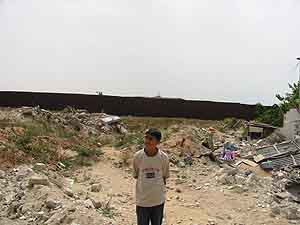



 « The situation is extremely difficult. Two
years ago in Rafah, South of the refugee camp the army had already destroyed
70 meters of houses along the cement wall that delimited the border with
Egypt. Only because israeli army decided arbitrarily that there must be
a security zone which can vary from 50 to 300 meters width, at its own
goodwill.
« The situation is extremely difficult. Two
years ago in Rafah, South of the refugee camp the army had already destroyed
70 meters of houses along the cement wall that delimited the border with
Egypt. Only because israeli army decided arbitrarily that there must be
a security zone which can vary from 50 to 300 meters width, at its own
goodwill.
 At
the place where there were houses in 2002, now
there is a second wall, an iron wall, and the
israeli army demolished houses further 70 meters from that new iron wall,
to widen more and more the so-called security zone. »
At
the place where there were houses in 2002, now
there is a second wall, an iron wall, and the
israeli army demolished houses further 70 meters from that new iron wall,
to widen more and more the so-called security zone. »


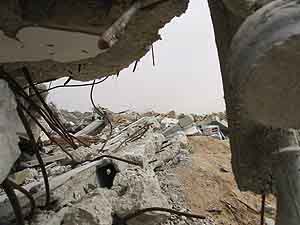


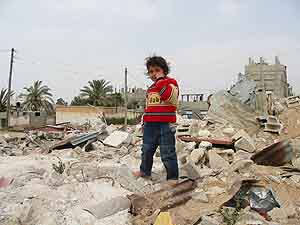


 Since
the beginning of intifada, israeli government destroyed more than 5'000
houses in Gaza Strip, generating 38'215 homeless
persons among which 19'372 children; in Rafah alone
2'200 houses were destroyed (15'622 homeless persons, 7'839 children).
Since
the beginning of intifada, israeli government destroyed more than 5'000
houses in Gaza Strip, generating 38'215 homeless
persons among which 19'372 children; in Rafah alone
2'200 houses were destroyed (15'622 homeless persons, 7'839 children).




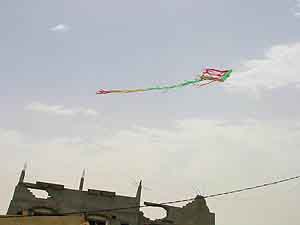
 Rafah,
refugee camp: a child flying a kite...
Rafah,
refugee camp: a child flying a kite...

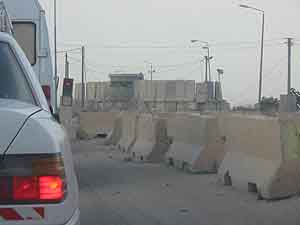
 AbuHouli
checkpoint: the israeli soldiers have total control on Palestinian transit
inside Gaza strip. Sometimes the checkpoint is closed for days, forcing
Palestinians to sleep in their cars. Sometimes the trafficlight is lit
green and red at the same time and if anyone dares to pass the soldiers
shoot at him.
AbuHouli
checkpoint: the israeli soldiers have total control on Palestinian transit
inside Gaza strip. Sometimes the checkpoint is closed for days, forcing
Palestinians to sleep in their cars. Sometimes the trafficlight is lit
green and red at the same time and if anyone dares to pass the soldiers
shoot at him.


 To pass the checkpoint each car has to count 2 passengers
minimum. Many children go back and forth through that checkpoint to allow
single drivers to pass, in exchange they ask for small money.
To pass the checkpoint each car has to count 2 passengers
minimum. Many children go back and forth through that checkpoint to allow
single drivers to pass, in exchange they ask for small money. A child
was asked what he thought of the current situation, he said: "I'm praying
every day for the situation not to change!" The economy is so desastrous
(more than 60% live below poverty level),
that this small mone earned by the children at the checkpoints has become
vital to their families…
A child
was asked what he thought of the current situation, he said: "I'm praying
every day for the situation not to change!" The economy is so desastrous
(more than 60% live below poverty level),
that this small mone earned by the children at the checkpoints has become
vital to their families… 

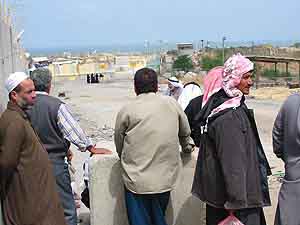
 KhanYunis,
Tuffah checkpoint.
KhanYunis,
Tuffah checkpoint.
 KhanYunis,Tuffah
checkpoint, entry of el-Mawasi - very strict rules are applied:
KhanYunis,Tuffah
checkpoint, entry of el-Mawasi - very strict rules are applied: - only
residents are authorized
- only
residents are authorized - they
can enter only by day at fixed hours
- they
can enter only by day at fixed hours - only
by foot and by groups of 5 persons
- only
by foot and by groups of 5 persons - ambulances
are not allowed (sick people and dead corpses have to be evacuated by foot...)
- ambulances
are not allowed (sick people and dead corpses have to be evacuated by foot...) Furthermore
the inhabitants of el-Mawasi (and other "yellow zones") are subject
to discriminatory and humiliating treatments
(body search at each passage, insults, etc).
Furthermore
the inhabitants of el-Mawasi (and other "yellow zones") are subject
to discriminatory and humiliating treatments
(body search at each passage, insults, etc). 


 KhanYunis:
humiliating body search at Tuffah checkpoint
KhanYunis:
humiliating body search at Tuffah checkpoint

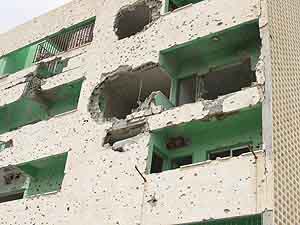


 « There are no words to describe the suffering
of people who still have the courage to stay in their house despite the
unceasing shootings, especially at night, from
israeli army. There is no words to tell all the indignation and anger
I felt witnessing this arrogance, the constant violation
of all elementary human rights,
this warlike and inhuman violence and above all, what a whole people has
to endure just to "secure" israeli presence in the region »
« There are no words to describe the suffering
of people who still have the courage to stay in their house despite the
unceasing shootings, especially at night, from
israeli army. There is no words to tell all the indignation and anger
I felt witnessing this arrogance, the constant violation
of all elementary human rights,
this warlike and inhuman violence and above all, what a whole people has
to endure just to "secure" israeli presence in the region »


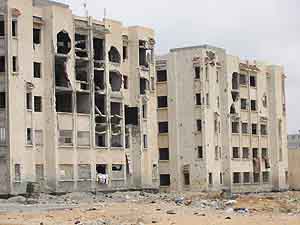



 « Where will all these people go?
« Where will all these people go?In Rafah refugee camp that israeli army is currently devastating, 92'000 inhabitants living on a few square kilometers. In Khan Yunis refugee camp there live 62'000 persons on 2 square kilometers, in Jabalyia, close to the city of Gaza, 120'000 inhabitants on 2 km, it's awful. In the Gaza strip there are 8 refugee camps and their density of population is one of the highest in the world. »





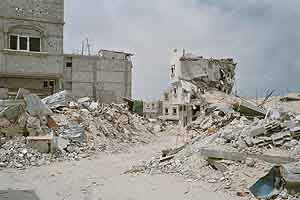
 KhanYunis:
the entry of the refugee camp...
KhanYunis:
the entry of the refugee camp... 

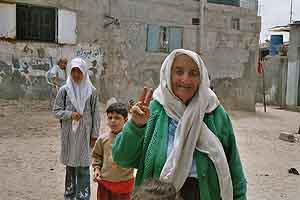



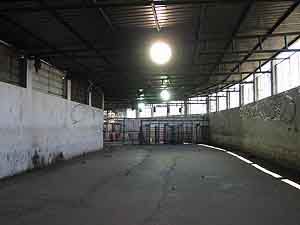
 Eretz:
the exit...
Eretz:
the exit... 
texts and pictures: A.A. April 2004